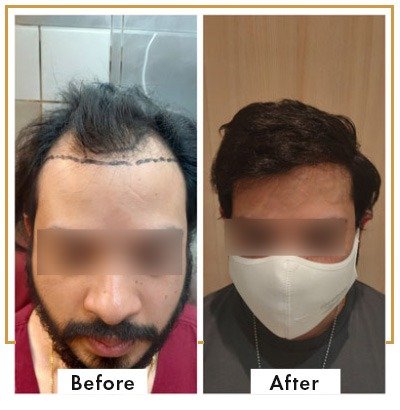
As a medical journalist passionate about uncovering real stories behind aesthetic treatments, I recently had the chance to visit Viva Aesthetic Clinic, a well-known destination for Hair Transplant in Mumbai. Sitting across from Dr. Deepam Shah, a renowned dermatologist and trichologist, I discovered more than just a clinic offering hair restoration—it was a space where medical precision meets aesthetic insight.
Meet Dr. Deepam Shah: The Mind Behind Viva Aesthetic Clinic
Dr. Shah’s background immediately stands out. An MD in Dermatology and a Fellow in Advanced Dermatology and Laser Surgery (USA), he combines both clinical depth and aesthetic finesse. Over the years, he has worked with numerous patients dealing with hair loss, skin disorders, and cosmetic concerns, bringing both science and empathy into his consultations.

At Viva Aesthetic Clinic, his approach to hair transplantation blends two popular techniques—FUE (Follicular Unit Extraction) and FUT (Follicular Unit Transplantation)—depending on the patient’s scalp condition, hair density, and long-term goals. The clinic itself is technologically updated, housing modern operation theaters, digital imaging systems for hairline design, and sterilization units that ensure safety at every step.
Understanding the Science of Hair Transplantation
Dr. Shah explained that hair transplantation is not just a cosmetic procedure but a medically guided art. It involves transferring healthy hair follicles, usually from the back of the scalp, to areas experiencing thinning or baldness. “It’s not about volume—it’s about direction, angle, and density,” he said, emphasizing that a natural outcome is what truly defines success.
While FUE offers minimal scarring and quicker recovery, FUT remains ideal for patients requiring larger graft coverage. Both procedures, however, demand an experienced hand to ensure uniform density and long-term follicle survival.
Other Doctors Performing Similar Treatments
To maintain a balanced perspective, I also spoke to two other Mumbai-based dermatologists:
- Dr. Rinky Kapoor, a celebrity dermatologist at The Esthetic Clinics, who focuses on minimally invasive hair restoration. She advocates FUE for its short downtime and recommends combining platelet-rich plasma (PRP) therapy for enhanced follicle strength.
- Dr. Viral Desai, founder of CPLSS (Centre for Plastic & Laser Surgery), who believes that the key to successful transplantation lies in detailed scalp mapping and post-surgical nutrition support.
Both doctors echo similar sentiments to Dr. Shah—that while hair transplant technology has evolved, patient awareness and realistic expectations are just as important.
The Pros and Cons of Hair Transplant Treatment
Like any medical intervention, hair transplantation has its strengths and limitations.
Pros:
- Permanent and natural-looking results
- Minimal maintenance once growth is established
- Safe when performed by experienced surgeons
- Customizable to patient goals and hair type
Cons:
- Requires patience—visible results take 8–12 months
- Temporary shock loss of existing hair may occur
- Mild post-surgical discomfort and swelling are common
- Results vary depending on donor area quality
Dr. Shah was transparent about the importance of medical eligibility. “Not every patient is an ideal candidate,” he noted. “We conduct scalp assessments and blood tests to rule out nutritional or hormonal causes before proceeding with surgery.”
What It Costs: Understanding the Financial Aspect
The cost of a hair transplant in Mumbai varies widely based on the number of grafts, doctor’s expertise, and clinic facilities. On average, the price ranges between ₹40,000 and ₹1,50,000 for smaller areas, and can extend beyond ₹2.5 lakh for full scalp restoration.
Dr. Shah emphasized that while cost is an important factor, patients should focus more on medical safety, hygiene standards, and the surgeon’s track record. “It’s better to invest in the right procedure once than regret an unqualified one later,” he shared.
Precautions and Aftercare: Insights from the Experts
Post-surgery care plays a crucial role in determining how well transplanted hair thrives. All three doctors offered similar guidelines:
- Avoid direct sunlight and excessive sweating for at least 10–14 days.
- Do not scratch or rub the transplanted area.
- Sleep in an elevated position for the first week to prevent swelling.
- Use prescribed mild shampoos and follow antibiotic or anti-inflammatory medications as directed.
- Avoid smoking and alcohol during recovery as they may hinder follicle growth.
- Follow-up visits at 1 week, 1 month, and 3 months help assess healing and early growth.
Dr. Shah adds an interesting perspective on emotional recovery too: “Hair restoration can be as much about self-confidence as aesthetics. We counsel patients to stay patient—good results are worth waiting for.”
🪞 A Thought to Leave You With
If you’ve ever caught yourself staring at the mirror, wondering when your hairline started changing, maybe it’s a sign to talk to someone who understands what you’re going through. Hair loss doesn’t need to be something you deal with quietly—sometimes just asking a few honest questions can make things feel a lot lighter.
And if you ever feel ready to explore your options, you can always reach out to Dr. Deepam Shah and his team at Viva Aesthetic Clinic. They’re quite easy to connect with—whether it’s a quick call or a simple message.
📞 +91 93245 89084 | 022 3573 1556
✉️ clinicvivacosmetic@gmail.com | shahdeepam@yahoo.co.in
They work from two easy-to-reach spots in Mumbai—one near the bustle of Opera House at Charni Road, and another calm corner near the Colaba seaside. Both places feel welcoming, and the timings are convenient enough even if your day is packed.
So if this has been on your mind for a while… maybe today’s a good day to finally talk about it.
